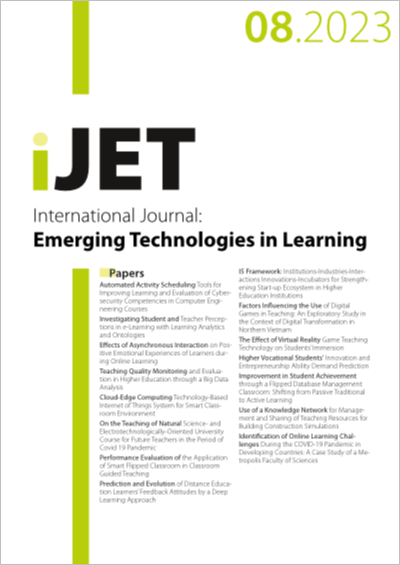Effects of Asynchronous Interaction on Positive Emotional Experiences of Learners during Online Learning
DOI:
https://doi.org/10.3991/ijet.v18i08.38703Keywords:
Online asynchronous interaction, Learners, Positive emotional experiences, Analysis of variance, Linear regression, Questionnaire technologyAbstract
Abstract—Online education is appreciated by an increasing number of people, and how to guarantee positive emotional experiences of learners during online learning becomes a core problem that has become the concern of education researchers. Online asynchronous interaction is an important communication method among learners during online learning. Owing to shortages and defects in time and space, interaction channel, and interaction content, online learning easily produces many “emotional blanks.” This research reviewed studies on online asynchronous interaction and emotional experiences at home and overseas. A total of 356 students majoring in Nursing from 5 universities in Henan Province were invited for the questionnaire survey. Influences of online asynchronous interaction, including people-to-system (P2S), people-to-people (P2P), and people-to-content (P2C), on the positive emotional experiences of learners were analyzed. Differences in positive emotional experiences under different weekly online asynchronous learning hours were estimated. Research results showed that Cronbach’s α of the questionnaire is 0.920, KMO value is 0.840, and the sphericity test significance is 0.000, indicating that the proposed questionnaire has very good reliability and validity. Evidently, P2S, P2P, and P2C can promote the positive emotional experiences of learners. Influences of weekly online asynchronous learning hours on frequency (F = 3.648, p = 0.006), intensity (F = 2.560, p = 0.038), and duration (F = 2.523, p = 0.041) of positive emotional experiences have statistical significance. Research results have important references in promoting online asynchronous interaction strategies, implementing specific interventions to online asynchronous interaction behaviors, and better providing convenient asynchronous online teaching services to students.
Downloads
Published
How to Cite
Issue
Section
License
Copyright (c) 2023 Ting Zhang, Shengnan Yu

This work is licensed under a Creative Commons Attribution 4.0 International License.


